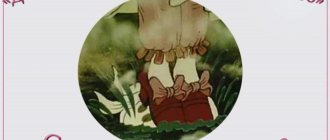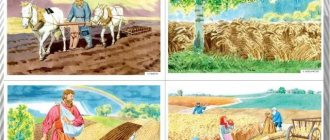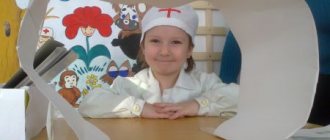Speech games and pictures for children on the topic “How bread is grown”
Today we will continue developing communication with our favorite whys on the topic of bread :).
Description of speech games
Game 1. Grammar game: “Guess what it is?”
Game Objective
– we learn to coordinate adjectives and nouns in gender and number, and develop the child’s linguistic sense.
Progress of the game
Ask your child to guess: “I thought of one word, and you try to guess what it is. Is rye flatbread or bread?” If the child made a mistake, for example, said: “rye is bread,” then you need to ask him, emphasizing the intonation of the ending of the word: “And we say “rye bread”? How do we talk? What kind of bread? Rye. So, what is rye? Cake".
Gradually, in such games, the baby learns to listen to words and their endings and will begin to answer more accurately and understand the algorithm for completing the task.
Sample riddles - questions for playing with preschoolers:
- Is rye a field or bread?
- Is wheat a spikelet or a field?
- Is wheat flour or cake?
- Is wheat flour or dough?
- Are rye spikelets or spikelets?
- Are wheat pies or flour?
- Are the bread crumbs or utensils?
- Bread – is it kvass or crumbs?
Game 2. Grammar speech game “Come up with a word.” We develop word creativity.
Options for tasks for preschool children:
Task 1. Dishes for sugar - a sugar bowl, for sweets - a candy bowl, and for bread? What is the name of the bread utensil? (A child’s formation of a word by analogy is breadbox).
Task 2. The device that cuts vegetables is called a “vegetable cutter,” but what is the name of the device that cuts bread? (The formation of the word by analogy is “bread slicer”).
Task 3. The factory where they make bread is called – what do you think? (There may be different options for the child’s answer, let the child come up with his own - “bread man”, “bread man” and any other options)
After this, tell your child: “The plant where fish products are produced is called a “fish factory.” What can a factory where bread is made be called? Try to guess."
If the child doesn’t guess, then say: “Yes, the words you came up with could really be in the Russian language. You came up with wonderful words! But people agreed to call it this. That’s why we say this: “Bread is baked on... ? (bread.
Where else can they bake bread? Tell them that bakers bake bread in a bakery. The bakery is large, many people work there. And the bakery is small. Several bakers work there.
Task 4. A person who grows bread and works in the field is called a “grain grower.” What do you call a person who bakes bread? Correct answer: baker.
Task 5. Guess the profession.
- Who works on the tractor? (tractor driver),
- Who works on the combine? (combiner)
- Who plows the land? (farmer).
- Who grows vegetables? (vegetable grower).
- Who grows beets? (beet grower).
- Who looks after the seeds? (seed grower).
- Who is working in the field? (field farmer).
- Who grows flax? (flax grower).
- Who grows the gardens? (gardener).
Game 3. Find the words
The task of the game. This is a vocabulary game in which we enrich and activate the child’s vocabulary. And at the same time we perform another task - we teach kids to listen attentively to speech and pay attention to expressive words.
Progress of the game
I usually play such games with children under 6 years old in the form of a puzzle game. The game form of the exercise interests and captivates children, because many modern children have a greatly reduced interest in speech, and speech exercises are difficult for them.
If you work with children enthusiastically, creatively, and playfully, then by the age of 6, children are so in love with word games that no “external” play support is needed. From this age, children are ready to do speech exercises without games, just in verbal form. They start playing speech games not for the sake of game results, but in order to find out and learn. Then our “external support” - the puzzle - simply becomes unnecessary.
But in the first stages you can’t do without playing. A preschooler really needs to see that he is choosing words for a reason (according to the principle “I was told, and I do it”). The baby needs to see that his actions have results that can be touched and seen. How can this be achieved? The technique I invented for “visual game assessment of children’s speech” will help us. Therefore, I propose to conduct this exercise as a game. Let's start playing :). Join us!
Step 1. Prepare material for the game.
A) Print out a picture of bread (below in the article you will find a link to download pictures for activities and games) and cut it into several squares. The number of squares depends on the age of the child. For small children 3-4 years old, 5-10 parts are enough, for children 5 years old and older - 10 or more parts.
B) Prepare additional small pictures or other surprises - this is a “bonus”, in case your baby picks up more words than we expected!
I have met children who could pick up to 25 - 30 (!!!) words in this game. Later they learned languages very easily at school. To play with such children, you need to cut the picture into more pieces in accordance with their high level of speech development.
Step 2. The goal of the game is to “bake bread”, i.e. collect all the pieces of the picture. Each word gives you the opportunity to get one part of the picture. You need to find as many words as possible and get all the pieces of the picture in the game.
You don't have to tell the baby. what will happen as a result of the game. Let it be a surprise for him - a mystery!
The game “What is it made from” to familiarize children with the world around them
The didactic game “What is made of what” is suitable for activities in kindergartens and at home. It introduces preschoolers to the basic physical properties of objects, teaches them to identify and generalize objects based on the materials from which they are made. The lesson is intended for kindergarteners of the senior and middle groups; it develops memory, concentration, and logical thinking.
Game “What is it made from” There are several options for an exciting activity for preschoolers, for each you need to prepare game material.
The purpose of the didactic game “What is made of what” is to improve the understanding of surrounding objects and the material from which they are made.
Game "What from what"
Tasks:
formation of ideas about the creation and physical characteristics of objects in the surrounding world; acquaintance with products made by human hands; formation of ideas about the purpose of various things and the significance of human labor; development of curiosity, expansion of horizons and vocabulary on the topic “Subjects”; training in the skill of comparison, determining cause-and-effect relationships; improving memory, concentration, speech skills, ability to think logically; developing the skills of teamwork and interaction with others.
Option 1 For the game you need to make boxes labeled “Metal”, “Rubber”, “Paper”, “Wood”, “Plastic”, “Wool”, “Flour”, “Glass”, and also cut out square pictures depicting objects and products made from the listed materials.
Several pupils or one child can play. The teacher asks leading questions. For example: “What is made from flour?” The player selects pictures of bread, cookies, cupcakes, pasta, pie and others and places them in the appropriate box.
What will happen to the body if you eat a handful of nuts every day What will happen to the body if you eat a handful of nuts every day Read more The most honest photos of Dolina have appeared on the Internet: it’s a nightmare The most honest photos of Dolina have appeared on the Internet: it’s a nightmare Read more It’s better to withdraw your pension right away from the card, and that’s why it’s better to immediately withdraw your pension from the card, and that’s why
Option 2 For the game you need to make spacious boxes with lids, label them “Metal”, “Wood”, “Plastic”, “Rubber”. Also find small objects made from these materials: a button, a balloon, a spool of thread, an eraser, a spoon, etc. The children’s task is to distribute the items into the boxes correctly.
During the game, you can experimentally determine the physical properties of things. Let the children touch them, try to bend them, scratch them.
Items
Option 3 For the game you need to prepare a playing field, divided into 4 sectors of different colors: “Metal”, “Wood”, “Glass”, “Plastic”. Draw empty cells in each sector. Also make pictures corresponding to the size of the cells, depicting objects made from the listed materials.
Participants are divided into 4 teams by sector. The teacher lays out the pictures face down. Children take turns taking cards. If the picture matches the team’s sector, it is placed on the cell; if not, it is returned to its place. The first team to fill all the cells in its sector wins.
You can also play questions. The teacher places the cards face down. Each participant takes a picture in turn, shows it to the others, and asks a question. For example: “Is the mug made of rubber?” or “What is the furniture made of?” Each player answers. Those who answer incorrectly receive a penalty badge. The winner is the player who has penalized the least number of times.
What is the furniture made of?
What are dishes made from?
Progress of the lesson:
When they say “Bon appetit?” This is what they say before eating. Today we will play and talk about what we eat.
When you are offered a treat - Fruit cake, sweets and cookies - Eat calmly, carefully. Everyone around will be pleased.
What should you say before eating? What should you say after eating?
Didactic game “Buy the exact same product in the store”
Children are given empty packaging of various food products. Children must go to the “store” (where the same packages are placed) and choose to “buy” exactly the same product.
Didactic exercise “What is inedible?”
Look at the picture carefully and show what is inedible and what cannot be eaten.
Children use pencils to draw vertical straight lines from the product to the plate.
Exercise "Pizza"
Prepare a real pizza - put slices of sausage, cheese, mushrooms, tomatoes on top.
Looking at pictures
You love to eat cookies, buns, bread. Look and listen to how and what they came from. (The display of pictures is accompanied by a story from an adult).
Picture "Ears". Picture "Grain". Picture "Flour". Picture "Dough". Picture “Bakery products”.
Didactic game “Grain Truck”
Place sheets of paper with a city drawn in front of you and pick up a grain truck. You will be the drivers and drive the car in the right direction.
Place the car in the upper left corner. There is a bakery here and fresh bread, rolls and other delicious products will be loaded into the car. Drive the car to the center, to the very middle. Now the car has moved to the right. Now down the street. The car stopped in front of a tall building. Then the car went to the left. She stopped behind a low house. The car drove up the street. The car returned to the bakery.
Application “Choose the dish of the desired shape”
We bought various products at a bakery store. Now you need to lay them out on the festive table. You don't have a tablecloth with dishes placed on it. Consider carefully bakery products and dishes for them. You need to choose a dish of suitable shape for each product. What geometric shape does a donut resemble? To the circle. What shape of dish should I place a round bagel on? On a round dish. What geometric shape does bread resemble? To a rectangle. What shape of dish should I place rectangular bread on? On a rectangular dish. What geometric figure does the loaf resemble? To the oval. What shape of dish should I place the oval loaf on? On an oval dish. What geometric shape does the pie resemble? To the triangle. What shape of dish should I place the triangular pie on? On a triangular dish. What geometric shape does the cookie resemble? Per square. What shape of dish should I place square cookies on? On a square dish.
Reading the poem "Bread"
Flour was kneaded into the dough. And from the dough we made: Pies and buns, Butter cheesecakes, Buns and rolls - We will bake everything in the oven. Delicious!
Modeling “Kolobok, loaf, bagel”
Take pieces of salt dough in your hands and roll a bun (circular rolling), a loaf (straight rolling, pressing, cutting), a bagel (straight rolling, folding, joining).
Dynamic pause “I bake, I bake, I bake”
Children perform movements as shown by an adult to the song “I bake, bake, bake.”
Didactic game “Put the food on plates”
Here are vegetables and fruits in front of you. Name them: cucumbers, tomatoes, plums, pears. Tell me what color they are? Green cucumbers, red tomatoes, yellow pears, blue plums. Place them on plates of a suitable color.
Didactic exercise “Sorting beans”
There are beans mixed on a plate. There are white beans, large ones, and there are brown beans, small ones. Place the large beans on large plates and the small beans on a small plate.
Didactic game “Arrange the candies”
Select candies of suitable shape and arrange them in the picture.
Game with clothespins “Candy on sticks”
Here are the sweets in front of you. Show the candy in red, yellow, blue, green. Now match each candy with a stick of the same color.
Handmade “Candy”
Pinch off large pieces from the salt dough, roll into a thick sausage and wrap in candy wrappers.
Reading the poem “Delicious porridge” by Z. Alexandrova
Buckwheat porridge, Where was it cooked? In the oven. Mated, reproached. So that Olenka eats it. They cooked the porridge, divided it among everyone... The geese on the path, the chickens in the basket, the tits in the window got a spoonful. A spoonful was enough for the dog and the cat. And Olya finished the last crumbs!
Manual labor “Porridge on a plate”
Spread glue (amply) in the middle of the plate and sprinkle cereal on top. Shake off or blow away any remaining cereal.
Didactic exercise “Divide in half”
Take scissors and cut the sausage and bread in half.
Show me a mushroom that is not like all the other mushrooms.
Didactic exercise “Drying mushrooms”
Squirrels dry mushrooms on tree branches. And people hang mushrooms to dry on a string. Now we will hang the mushrooms to dry on a string using clothespins.
Dance exercise “Dance with Mom”
Children perform movements to the music according to the text.
Didactic exercise “Good and bad”
Children look at the picture and explain which child behaves well at the table and which one behaves poorly.
How do you behave at the table? Try to eat carefully. So as not to get dirty. Use a napkin. To wipe your mouth after eating. Show how you wipe your mouth with a napkin.
Manual labor “Bundle of dryers”
Children string dryers onto a string, and adults help tie a knot on the string. Children take a bunch of dryers with them.
Olesya Kirzhaeva
ODR senior group on the theme of the week “Bread is the head of everything”
Thematic selection of games and exercises, topic: “Food”
Goals:
Expand children's knowledge about food. Enrich children's active and passive vocabulary on this topic. Learn to listen carefully and understand poetic text. Form ideas about color, position in space (on, behind, in front, next to, top-bottom, right-left), geometric shapes (rectangle, square, triangle, circle, oval), size (big-small). Teach children to find exactly the same object, as well as an object that is different from the rest. Improve the skills of gluing, sculpting, and drawing straight vertical lines with a pencil. Teach children to find the middle of an object. Teach children to cut paper with scissors. Develop thinking, fine motor skills, coordination of movements. Practice the ability to coordinate your actions with the words of the song. Foster a desire to be careful when eating and use a napkin.
Equipment:
Packaging for various food products (two copies each). Pictures “Find the extra item” (food). Cardboard plates, PVA glue, buckwheat. Salt dough, toy knives, candy wrappers. Pictures depicting ears of grain, grains, flour, dough, bakery products. Leaf background with a picture of a road. Small cars. Sheet-background with images of plates of different shapes; cut out color images of bread, cookies, pie, loaf, bagel; glue. Large white and small brown beans. Large and small plates. Scissors. Paper-cut images of bread and sausage. Clothespins. Multi-colored silhouette images of lollipops. Handouts “tomatoes”, “cucumbers”, “pears”, “plums”; circles-plates of red, blue, yellow and green colors. Clothesline. Silhouette images of mushrooms. Drying. Strings. A picture of a neat and messy child eating. Paper napkins. Round cardboard “pizzas” with Velcro, small pieces of sausage, tomatoes, mushrooms, cheese on Velcro. Pictures-backgrounds depicting candies in the form of geometric shapes with an empty middle, corresponding geometric shapes. Pencils. Sheets with food items drawn at the top and plates at the bottom, which need to be connected by a vertical line. Audio recordings: “Dance with Mom”, “I bake, bake, bake a pie for all the kids.”




